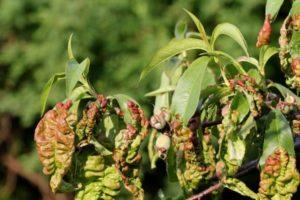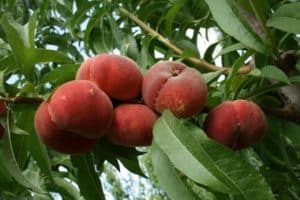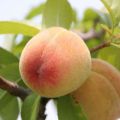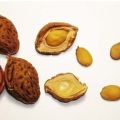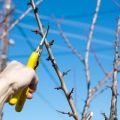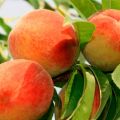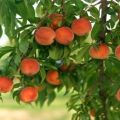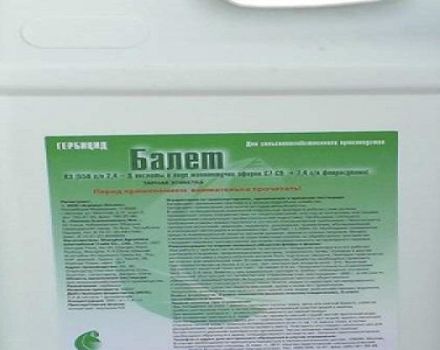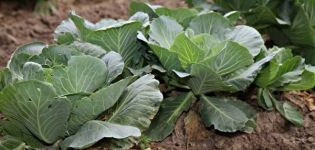When and how to prune peaches to form a tree
One of the capricious crops, peach, requires increased attention and knowledge of agricultural technology from the gardener. In care, the formation of the crown of a garden culture, the regulation of fruiting by pruning is considered a mandatory procedure. Without it, the tree will not be able to develop correctly, and high yields depend directly on this procedure. But not everyone knows how to trim a peach to get a positive result.
Content
- 1 Aims and objectives of pruning
- 2 What tools and materials will be needed
- 3 Types of pruning
- 4 Terms of work
- 5 Why Autumn Pruning Increases Yields
- 6 How growing area affects pruning timing
- 7 Technology and sequence of formation of various types of crowns
- 8 On a mote substitution
- 9 Features of the procedure
- 10 Care after pruning
- 11 Common mistakes
Aims and objectives of pruning
For the peach fruit crop, the role of annual pruning is to:
- to activate the growth of young shoots;
- increase the time of fruiting;
- rejuvenate the tree;
- increase the resistance of the peach to frost and disease;
- make the crown neat and aesthetic.
The peach tree will not be able to "feed" all the shoots that have appeared, so the extra ones must be removed. Then there will be enough strength to ripen the fruits. And to increase the sugar content of the crop, sunlight is needed. With a thickened crown, this will not happen.
Therefore, peaches on the branches will rot more often, since they do not have enough air for airing.
A regularly performed procedure will renew the tree, make the crop productive, with strong immunity.
What tools and materials will be needed
In order to prune the extra peach branches, you need to prepare for the procedure. Be sure to remove branches:
- pruning shears with tightly fitting cutting edges;
- lopper with long handles;
- garden saw;
- garden knife;
- scissors, which have rounded blade ends and strong handle rings.

All tools sharpen well, using them to trim both thin and thick shoots. You can only remove thick branches with a saw, and for medium branches, a delimber is suitable. Thin twigs and weak growth can be trimmed with scissors or pruning shears, sharp, without jagged edges on the cutting surfaces.
It is necessary to have a sharpening circle nearby in case the saw or knife becomes dull. Before using the tool, the cutting parts are disinfected by wiping with medical alcohol or immersed in a solution of potassium permanganate. Prepare garden pitch and disinfectant solutions for processing damaged wood immediately before the procedure.
Types of pruning
For fruit crops growing upward, pruning is needed, the purpose of which is to form a bush with 4-7 skeletal branches. But there are several types of pruning, which have different goals and objectives. They are used depending on the age of the tree, the season.
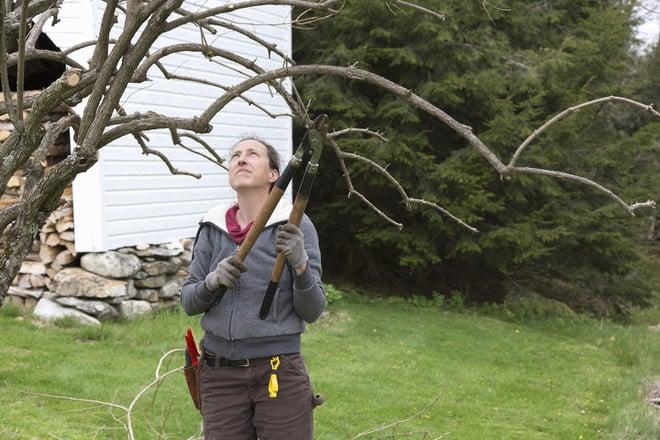
Formative
They begin to form the crown of the tree even in the nursery, when the seedling is being prepared. By cutting off the top of the main shoot, branching of the crown is achieved. In the future, annual branches are annually shortened, achieving the formation of a rounded or cup-shaped crown with the correct arrangement of branches. Every year the degree of pruning is reduced, and the shortening is stopped when the crown has formed and the tree has begun to bear fruit.
Anti-aging
Old peach trees need this pruning method. The fruiting peach branches are removed to the place where good tops have grown, and from the new shoots they leave the part that will fill the bare places.

Restorative
Both in the spring and in the summer, they carry out the peach recovery procedure after winter and fruiting. Thinning the crown, they remove defective thickening branches, and if necessary, healthy and poorly developed ones. When thinning, the crown lightens, and the fruiting zone approaches the base of the shoots.
The need for pruning is to turn growth shoots into fruiting ones. The procedure helps prevent premature death of fruit twigs.
Regulatory
When a large number of ringlets are formed, the older ones are cut off. If this is not done, then the number of fruits on the peach will decrease, they will become smaller. Uncut trees do not bear fruit every year. This is how the time and duration of the appearance of peaches on the tree are regulated by pruning.
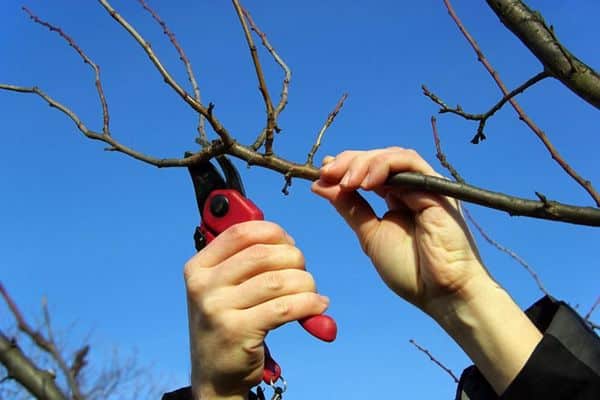
To regulate the shape of the peach, shortening of annual shoots is carried out if they are more than 50 centimeters and sharply go beyond the boundaries of the crown.
Terms of work
It is necessary to carry out all types of pruning at a certain time when the need for the procedure has come. You cannot ignore the pruning rules, otherwise it will affect the fruiting of the peach, its vegetation. Work is carried out in two ways: with the complete removal of the branch or shortening it.
Spring
Thinning of branches begins with complete removal of some of them in February, in the spring, continuing to shorten annual shoots, achieving branching of the crown. The procedure is carried out depending on which shape was chosen for the peach tree. It is necessary to remove one third or half of the length of the annual growth, and on branches of the first order, they cut more strongly than the second order. It is important to maintain a young growth, because most of the fruits are formed on 2-3-year-old branches.
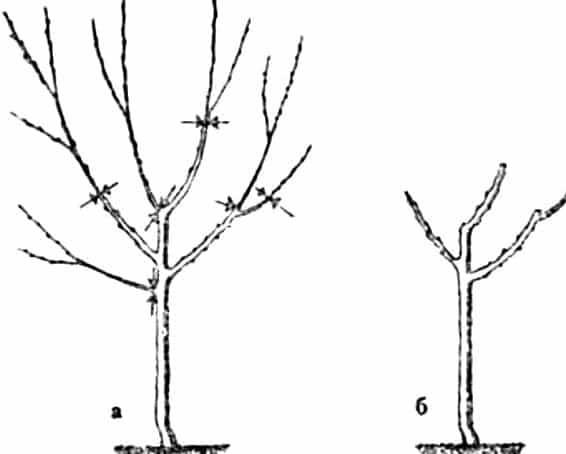
They begin to thin out before the start of the movement of the juices at the plant, as soon as the snow melts. Then the peach will recover faster after pruning.
Summer
In summer, the peach is pruned for sanitary purposes, clearing the crown from dry branches. Thickening of the crown is often found when flowers fall. Therefore, summer pruning will eliminate those branches that grow incorrectly, inside the crown. It is best to carry out the procedure at the end of June. It is possible in July, when the seeds are laid in peaches.
Many are not sure if it is possible to cut the branches with fruits. The procedure is carried out when there are so many fruits that the branches are overloaded with them.
The nuances of autumn pruning
The formation of a peach crown, according to experienced gardeners, should be carried out in the fall. A procedure carried out in summer or spring will lead to a decrease in stone fruit yields. Autumn pruning is especially suitable in warm climates. It is carried out after harvesting, while it is kept warm. There is a lot of time before the onset of a cold snap, and the tree will quickly recover from pruning.
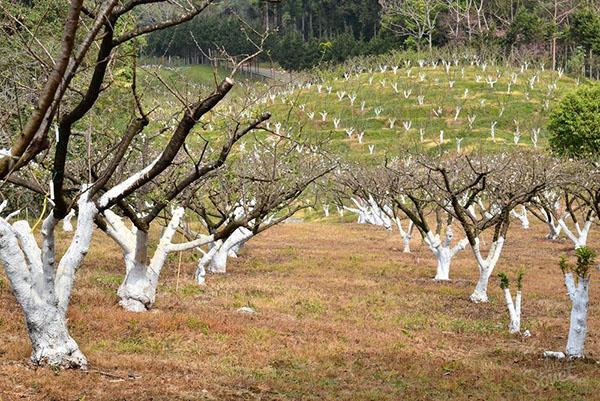
The optimal time for the formation of the peach crown will be early September to mid-October, after harvest. But do not forget that the autumn procedure is not carried out in areas with a temperate climate.This can be fatal to the peach. A weakened tree will not survive the early winter.
Why Autumn Pruning Increases Yields
A peach does not give full-fledged fruits if it has strong vegetative growth and a thickened crown. The gardener can guide the development of the tree in the right direction. It is pruning in the fall after fruiting that it is easier to carry out in order to correct the angles of branching and remove unnecessary shoots.
So that there is a good harvest and the fruits do not interfere with each other, weak growths are shortened by 25 centimeters, and fruiting ones by 35-40. Leave on the last up to 4-8 groups of kidneys. After wintering, the tree will begin to develop rapidly, bloom and bear fruit successfully. Pruning in spring will postpone the fruit-laying period.
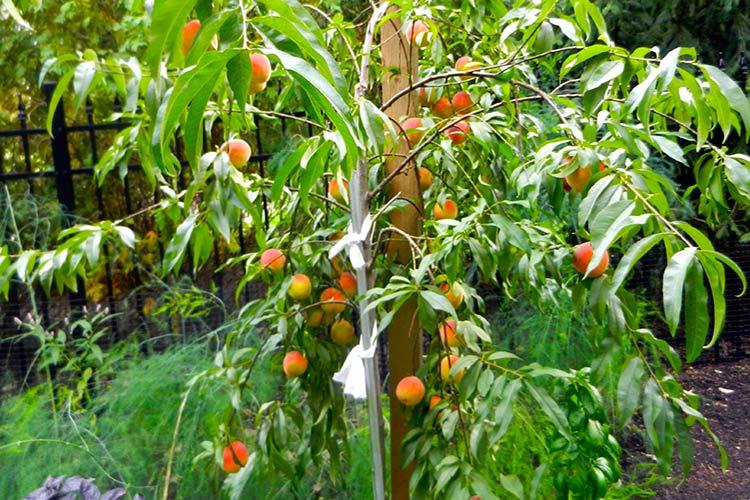
How growing area affects pruning timing
The timing of peach pruning depends on where the plant is cultivated. In the south of Russia, it is necessary to carry out all types of pruning in the fall. Then the fruiting will increase, and the tree will delight with peaches regularly.
In central Russia, winter comes earlier, and when pruning a peach in autumn, it will not have time to adapt. Therefore, it is necessary to carry out shortening and thinning of branches in the spring, less often in the summer. It is better to do it in the early stages, until the sap flow has begun. So the wounds will heal faster. In autumn, only regulating and sanitary pruning is carried out.
Technology and sequence of formation of various types of crowns
Before starting formative pruning, it is necessary to determine what type of crown will be made. Each type has its own scheme of the procedure. It is reasonable to shorten and remove branches and shoots, then the result of pruning will be positive. To do it correctly, step by step actions are determined.
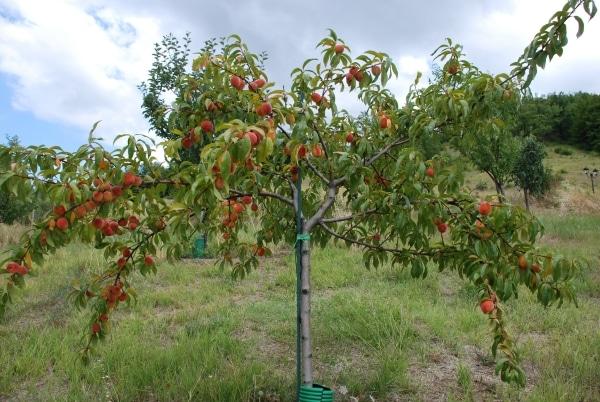
Cup-shaped
Start pruning in the fall if the peach is planted in the spring. An annual seedling is cut off the top by 50 centimeters. Be sure to leave 2 buds on the shoot from different sides of the trunk. By shortening the lateral branches, they stimulate the development of one-year growth.
In the second year of a peach's life:
- The central shoot is cut to the point where the side branches extend from the trunk if they are half a meter long.
- With a small growth, only 30-40 centimeters, shorten to the last growth bud.
- Leave 2-3 developed shoots on the branches, the rest are removed to the first leaf, located closer to the trunk.
After a year, the branches of the first order are shortened by a third. You need to leave 3 branches on them, removing the growth buds from them, looking down. When peaches appear in the 4th year, it remains only to cut off shoots to the base, on which there were no inflorescences.
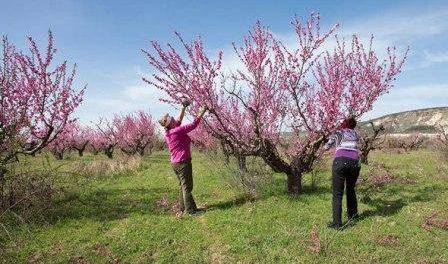
The cup-shaped crown will be based at the bottom on 4 skeletal branches, and at the top on 5. Up to 80 fruiting branches are left in an adult plant.
Bushy
Such a crown is also popular along with a bowl-shaped one. Formation by a bush allows:
- improve the illumination of all peach branches;
- increase productivity;
- make the tree resistant to frost;
- facilitate the care of the crop, collection of fruits.
In the bush version, there is no crown of the central shoot, but only 3-4 branches extending sideways, located in the lower quarter of the peach trunk. Form peach bushes:
- cutting off the central shoot and side branches in the fall to the point of growth;
- leaving during the first procedure 3-4 lower shoots with 5 growth buds on each;
- choosing 6-8 main branches for the next year, cutting off the rest to the first leaf;
- after fruiting, leaving correctly positioned shoots, cutting out the rest.
Each year they regulate the growth of shoots and branches, trying to maintain the shape of the crown. If the branches leave less than 45 degrees, then they are tied to a peg.
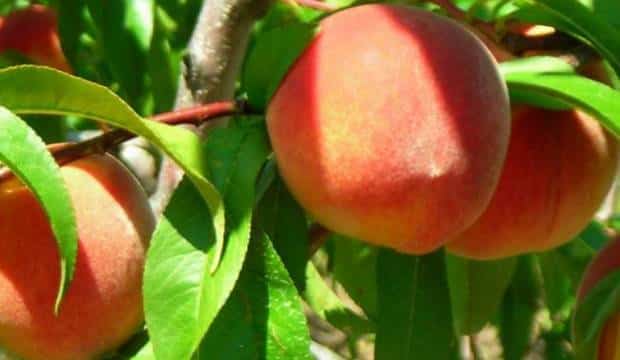
On a mote substitution
The green peach trim is kept short. To do this, 2 eyes are left on the branches, from which 2 shoots grow. One will bear fruit, and the second will replace it for the next year.Then the top is cut off at the top, and 2-3 buds are left on the lower knot. This method helps to stop first order limb exposure. And the fruits will appear on last year's gain.
Fan
When creating a fan-shaped crown, it is necessary to trim the branches so that they are located closer to each other, at a distance of 10-15 centimeters. They create a powerful type of tree from the first year of life. First, the central shoot is cut off, and the side branches are left in an amount of 3-4 pieces. They should be at a 45 degree angle. So they continue to prune annually. When branches appear at the top of the central shoot, then 2, the strongest, are left. It is necessary to leave up to 90 fruiting branches on the tree. With insignificant yields, it is increased to 100-120.
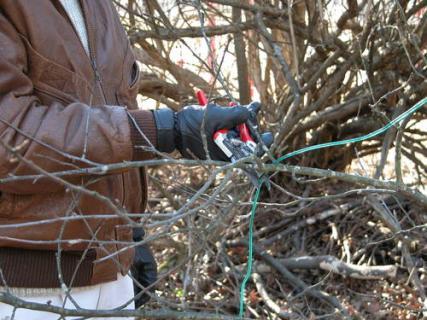
This crown is chosen by farmers who are engaged in industrial cultivation of peaches. The peculiarity of trees is that they do not break from the wind, they survive in snowy winters.
American
According to American technology, the crown is thinned out manually. They start with flowers, when the extra ones are picked. During the period when the ovaries appear, the peach is examined. And too small, damaged ovaries are removed. At the same time, the load on the branches is regulated. When there are many fruits, the tree will not have enough strength to bring them to technical maturity.
Correct the work done after 1-2 weeks. After such work, the weight of the fruits on the peach will be the same, and everyone will have enough light and air. Thanks to the American method, new fruit buds are laid.
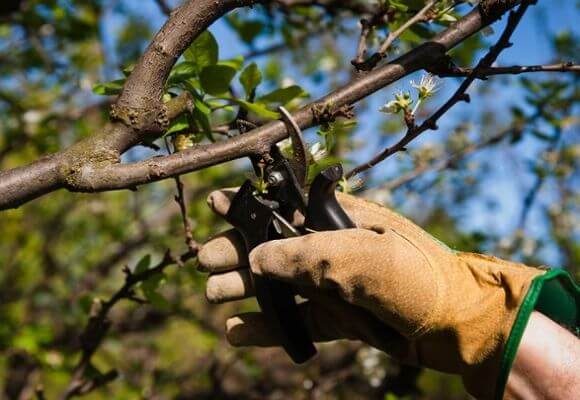
Features of the procedure
It is necessary to remove and shorten tree branches taking into account the age of the peach. For young trees, it is necessary to direct agrotechnical actions for growth and development, preparation for fruiting. In ripe peaches, the formation of fruits is regulated by pruning, removing their excess. An old plant needs rejuvenation.
For young seedlings
Peach is planted with shortening the top of the central shoot. The side branches are also pruned by a third. Then they continue pruning annual shoots, forming a crown with the correct arrangement of skeletal branches. It is necessary to remove their length by at least a third. When the growth is weak, up to 25-30 centimeters, then you can not touch the young peach.
For fruiting trees
After 3-4 years, the peach does not need to be shortened, which can lead to a lack of harvest. Now the emphasis is on thinning with the removal of weak, frozen branches. Be sure to remove those branches that lead to thickening of the crown.
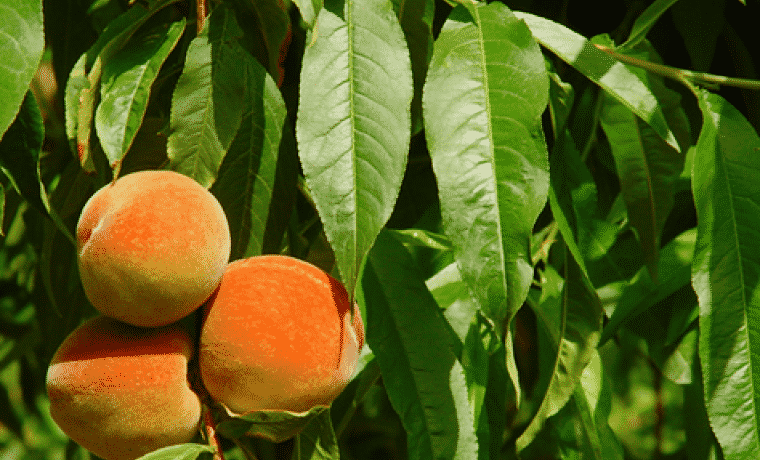
The shortening of shoots 50 centimeters long is partially carried out. Growths less than 20 centimeters long will have to remove some of the two-year-old wood. This will cause strong growth to appear.
For an old peach
To rejuvenate a tree that is no longer bearing fruit, it is necessary to shorten the skeletal branches of the first order by a third of their length. The tops left on the peach also need to be shortened, leaving a length of 50-60 centimeters.
Care after pruning
After the procedure, a number of measures must be taken to help the tree adapt, protect it from diseases and pests:
- After collecting the cut branches, they burn them.
- The wounds on the peach are treated with garden pitch, small cuts - with a solution of potassium permanganate or boric acid.
- For the winter, they wrap the peach trunk with a thick cloth.
- Whiten the peach with special solutions.
- Water after autumn pruning abundantly so that moisture accumulates in the soil.
- In the spring, you can lay a layer of mulch in the area of the trunk circle.
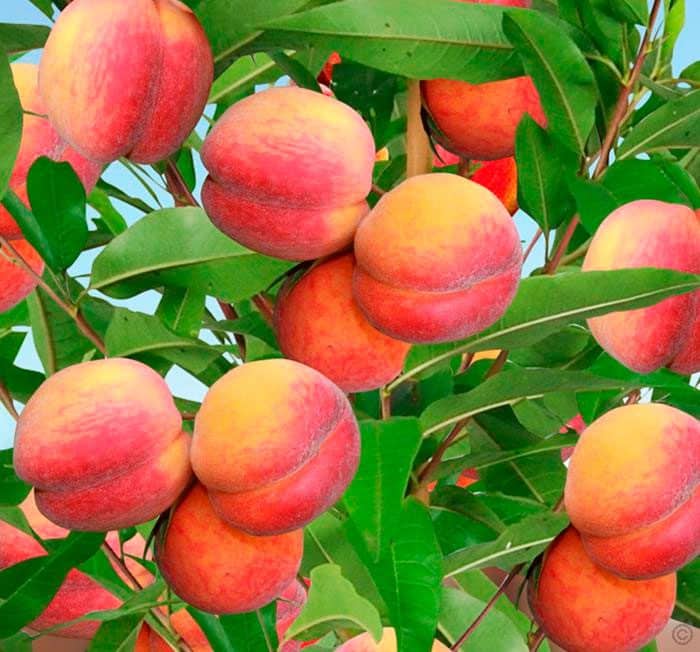
It is necessary to treat the tree carefully after pruning, like a patient after an operation.
Common mistakes
There are a number of mistakes when peach pruning is done incorrectly. And then one should not be surprised that the tree does not bear fruit. When limbs are shortened during fruiting, they lose the crop. Strongly cutting off the branches of a young tree, delay the beginning of fruiting. This is especially true for healthy trees.
Many do not prune peaches, considering it an unnecessary procedure. Hence, small fruits and irregular fruiting... Be sure to start the pruning procedure only with biennial plants. If the branches are less than 45 degrees away from the trunk, then they are tied to a peg. You should not start shortening early, otherwise the peach may die.
Do not forget that the degree and method of pruning is chosen depending on the structure, age of the peach, and the variety of culture. It is easy to shorten the branches greatly, but this leads to oppression of the plant, although the annual growth will be strong and abundant.
